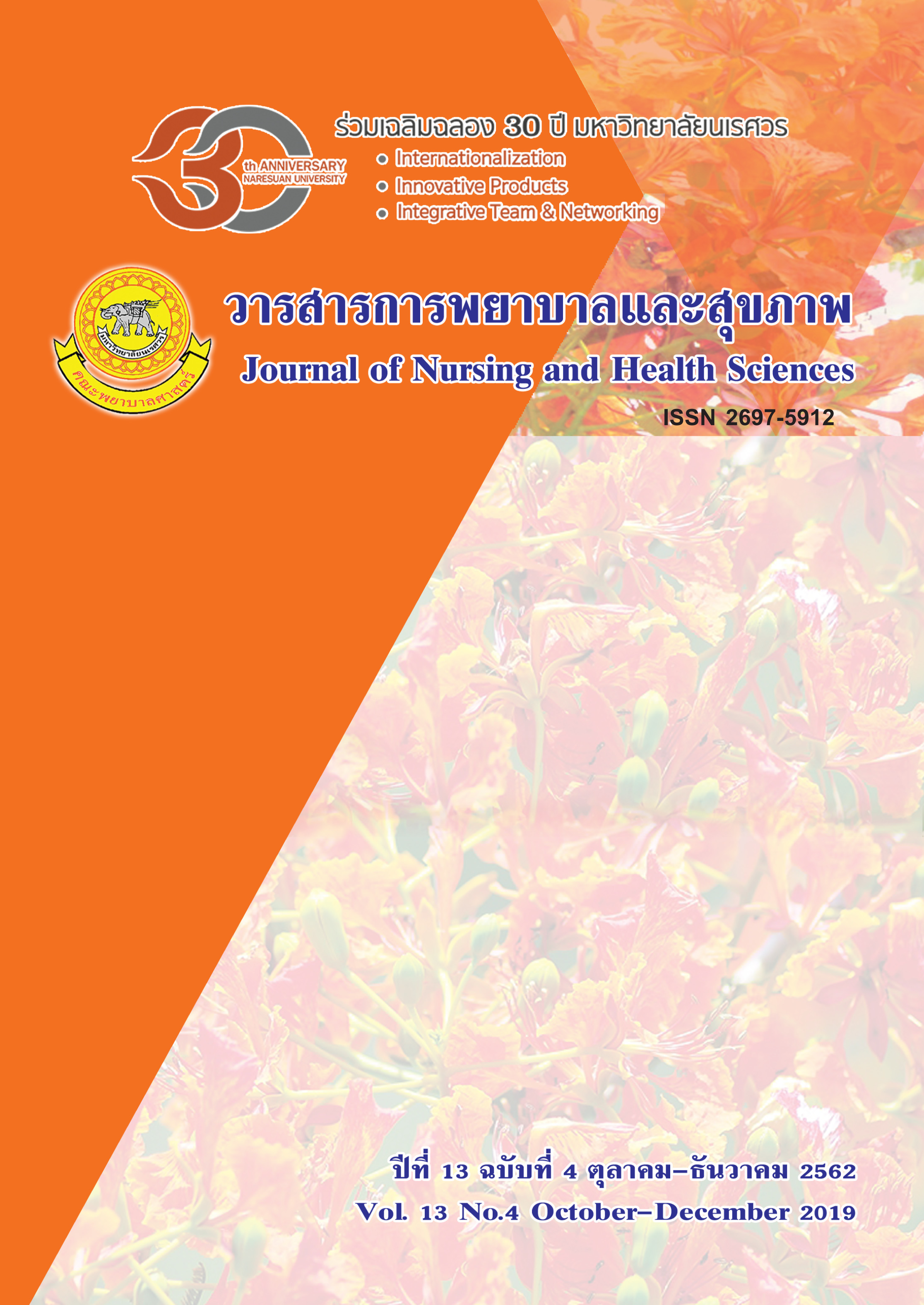ปัจจัยที่เกี่ยวข้องกับพฤติกรรมการดูแลเด็กป่วยโรคปอดอักเสบของผู้ดูแล ในโรงพยาบาล เขต 5 กระทรวงสาธารณสุข
Main Article Content
บทคัดย่อ
โรคปอดอักเสบในเด็กที่มีอายุต่ำกว่า 5 ปี เป็นปัญหาสาธารณสุขที่สำคัญของประเทศไทย การวิจัยครั้งนี้ เป็นการศึกษาพฤติกรรมการดูแลเด็กป่วยโรคปอดอักเสบและศึกษาความสัมพันธ์ระหว่างการรับรู้ความรุนแรงของ โรคปอดอักเสบในเด็กและการรับรู้อุปสรรคของการปฏิบัติในการดูแลกับพฤติกรรมการดูแลของผู้ดูแลเด็ก โรคปอดอักเสบ กลุ่มตัวอย่างที่ใช้ในการวิจัยเป็นผู้ดูแลของเด็กป่วยโรคปอดอักเสบที่มีอายุต่ำกว่า 5 ปี ที่มารับ การรักษาที่หอผู้ป่วยในและผู้ป่วยนอก แผนกกุมารเวชกรรม โรงพยาบาลราชบุรี โรงพยาบาลสมุทรสาคร และ โรงพยาบาลเจ้าพระยายมราช จำนวน 92 ราย คัดเลือกกลุ่มตัวอย่างโดยแบบเจาะจง เครื่องมือที่ใช้ในการวิจัยประกอบ ด้วย แบบสอบถามพฤติกรรมการดูแลของผู้ดูแลเด็กโรคปอดอักเสบ แบบสอบถามการรับรู้ความรุนแรงของโรคปอด อักเสบในเด็ก และการรับรู้อุปสรรคของการปฏิบัติในการดูแลเด็กโรคปอดอักเสบ ค่าดัชนีความตรงของเนื้อหา ของแบบสอบถามพฤติกรรมการดูแลของผู้ดูแลเด็กโรคปอดอักเสบเท่ากับ 0.92 และมีค่าความชื่อมั่นเท่ากับ 0.80 วิเคราะห์ข้อมูลโดยใช้สถิติพรรณนาและสถิติสัมประสิทธิ์สหสัมพันธ์แบบเพียร์สัน ผลการวิจัยพบว่า ผู้ดูแลเด็กโรคปอดอักเสบมีคะแนนเฉลี่ยของพฤติกรรมการดูแลของผู้ดูแลเด็ก โรคปอดอักเสบโดยรวมอยู่ในระดับสูง (ร้อยละ 70.7) พฤติกรรมการดูแลของผู้ดูแลเด็กโรคปอดอักเสบมีความสัมพันธ์ ทางบวกระดับปานกลางกับการรับรู้ความรุนแรงของโรคปอดอักเสบในเด็กอย่างมีนัยสำคัญทางสถิติ (r = .341, p < .01) และพฤติกรรมการดูแลของผู้ดูแลเด็กโรคปอดอักเสบมีความสัมพันธ์ทางลบระดับต่ำกับการรับรู้อุปสรรคของ การปฏิบัติในการดูแลของผู้ดูแลเด็กโรคปอดอักเสบอย่างมีนัยสำคัญทางสถิติ (r = -.225, p < .05) ผลการวิจัยนี้ สามารถนำไปเป็นข้อมูลพื้นฐานในการป้องกันการเกิดโรคอักเสบในเด็กอายุต่ำกว่า 5 ปี และช่วยให้ผู้ดูแลได้พัฒนา พฤติกรรมการดูแลและสามารถป้องกันการกลับเป็นโรคปอดอักเสบซ้ำในเด็กนี้ได้
Article Details
เอกสารอ้างอิง
Becker, M. H. (1974). The health belief model and sick role behavior. New Jersery: Chares B. Slack.
Burns, N., & Grove, S., (2009). The practice of nursing research: Appraisal, synthesis, and generation of evidence (6th ed.). St. Louis: Elsevier.
Chumjun, J. (2008). Effect of individual education program on child care behaviors perceived by mothers of children aged under 5 years with recurrent pneumonia. Master Thesis (Pediatric Nursing), Prince of Songkla University, Songkhla. Available from http://kb.psu.ac.th/psukb/bitstream/2010/5549/1/311137.pdf. [In Thai].
Deerojanawong, J. (2007). Pediatric respiratory diseases: Integration of clinical sciences into practices. Bangkok: Thai Association of Pediatric Respiratory and Critical Care Medicine. [In Thai].
Department of Disease Control Ministry of Public Health. (2015). Pneumonia. Retrived 1 September 2018 from http://www.boe.moph.go.th/Annual/AESR2015/aesr2558/Part%201/05/pneumonia.pdf. [In Thai].
Huang, C.-Y., Chang, L., Lie, C.-C., Huang, Y. C., Chang, L.-Y., Huang, Y.-C., ...Huang, L.-M. (2013). Risk factors of progressive community acquired pneumonia in hospitalized children: A prospective study. Journal of Microbiology, Immunology, and Infection, 48(1), 36-42. doi:10.1016/j.jmii.2013.06.009
Jaide, C., Sansati, S., & Kongsaktrakul, C. (2012). Factors related to child care workers’ behavior in prevention of acute respiratory infection in child care center. Ramathibodi Nursing Journal, 18(3), 389-403. [In Thai].
Kamalaporn, H. (2013). Pmeumonia. In A. Preutthipan, T. Chaisupmongkollarp, J. Utrarachkij, H. Kamalaporn, & T. Kuptanon (Eds.), The essentials of pediatric respiratory care (2nd ed., pp 413-423). Bangkok: Beyond Enterprise. [In Thai].
Katona, P., & Katona-Apte, J. (2008). The interaction between nutrition and infection. Clinical Infectious Disease, 46(10), 1582-1588. doi:10.1086/587658
Kelley, L. K. (2007). Manageing acute cough in children: Evidence-based guidelines. Journal of Pediatric Nursing, 33(6), 515-523.
Lazzerini, M., Seward, N., Lufesi, N., Banda, R., Sinyeka, S., Masache, G., ...Colbourn, T. (2016). Mortality and its risk factors in Malawian children admitted to hospital withclinical pneumonia, 2001-12: A retrospective observational study. The Lancet Global Health, 4(1), e57-e68.
Ngamsuoy, A., & Suklerttrakul, T. (2008). Impact of illness and hospital admission on children patient. In M. Urharmnuay, S.Lamchang, J. Yenbut (Eds.), Pediatric nursing I (pp 15-32). Chiang Mai: Nuntapun Printing. [In Thai].
Odunayo, S. I., & Oyewole, A. O. (2006). Risk factors for malnutrition among rural Nigerian Children. Asia Pacific Journal of Clinical Nutrition, 15(4), 491-495.
Owayed, A. F., Campbell, D. M., & Wang, E. E. (2000). Underlying causes of recurrent pneumonia in children. Archives of Pediatrics & Adolescent Medicine, 154(2), 190-194.
Pediatric Infectious Disease Society of Thailand. (2016). Diseases come with cold weather 2: Pneumonia. Retrieved 1 September 2018 from http://www.pidst.net/A288.html. [In Thai].
Polit, D. F., & Beck, C.T. (2010). Generalization in quantitative and qualitative research: Myths and strategies. International Journal of Nursing Studies, 47(11), 1451-1458. doi:10.1016/j.ijnurstu.2010.06.004
Prapphal, N. (2009). Pneumonia. In N. Prapphal, J. Deerojanawong, S. Chatproedprai, V. Chongsrisawat, & S. Chomtho. (Eds.), Common problem in pediatrics: Guideline for treatment (pp 577-588). Bangkok: Beyond Enterprise. [In Thai].
Ratanachu-ek, S. (2012). Pediatric nutrition handbook (3rd ed.). Bangkok: Chai Jareon. [In Thai].
Rudan, I., O’Brien, K.L., Nair, H., Liu, L., Theodoratou, E., Qazi, S...Campbell, H. (2013). Epidemiology and etiology of childhood pneumonia in 2010: Estimates of incidence, severe morbidity, mortality, underlying risk factors and causative pathogens for 192 countries. Journal of Global Health, 3(1):010401. Retrieved 1 September 2018 from: https://www.ncbi.nlm.nih.gov/pmc/articles/PMC3700032/pdf/jogh-03-010401.pdf.
Sakulcool, R. (2014). Incidence and risk factors for recurrent pneumonia among children. Buddhachinaraj Medical Journal, 31(1), 46-53. [In Thai].
Schaible, U. E., & Kaufmann, S. H. (2007). Malnutrition and infection: Complex mechanisms and global impacts. PLoS Medicine, 4(5), e115. https://doi.org/10.1371/journal.pmed.0040115.
Scott, J. A. G., Wonodi, C., Moïsi, J. C., Deloria-Knoll, M., DeLuca, A. N., Karron, R. A., ...O’Brien, K. L. (2012). The definition of pneumonia, the assessment of severity, and clinical standardization in the pneumonia etiology research for child health study. Clinical Infectious Diseases, 54(Suppl. 2), S109-S116.
Senngam, K. (2008). Pediatric critical nursing care in respiration. Songkhla: Faculty of nursing Prince of Songkla University. [In Thai].
Sinaniotis, C. A. (2005). Community-acquired pneumonia in children. Current Opinion in Pulmonary Medicine, 11(3), 218-225.
Soto-Martínez, M. E., & Penon, M. (2014). Recurrent lower respiratory tract infections in children. Retrieved 2 September 2018 from http://www.medicalobserver.com.au/news/recurrent-lower-respiratory-tract-infections-in- children
Srasom, C., Klunklin, P., & Thaiyapirom, N. (2011). Effectiveness of preventive interventions for acute lower respiratory tract infection among children under the age of five: A systematic review. Nursing Journal, 38(4), 123-142. [In Thai].
Supreeyaporn, S. (2017). Factors related to caring behaviors among caregivers of children with recurrent pneumonia. Master Thesis (Pediatric Nursing), Chiang Mai University, Chiang Mai. [In Thai].
Van der Kam, S., Salse-Ubach, N., Roll, S., Swarthout, T., Gayton-Toyoshima, S., Jiya, N. M., . . . Shanks, L. (2016). Effect of short-term supplementation with ready-to-use therapeutic food or micronutrients for children after Illness for prevention of malnutrition: A randomised controlled trial in Nigeria. PLoS Medicine, 13(2), 26p. https://doi.org/10.1371/journal.pmed.1001952
Wilson, D. (2009). The child with respiratory dysfunction. In M. J. Hockenberry & D. Wilson (Eds.), Wong’s essentials of pediatric nursing (8th ed.). St Louis: Mosby.
World Health Organization. (2016). Pneumonia in children. Retrieved 2 September 2018 from http://www.who.int/ mediacentre/factsheets/fs331/.
Yordin, M. (2004). Factors related to caring behaviors among mothers of children with acute respiratory tract infection. Master Thesis, Srinakharinwirot University, Bangkok. [In Thai].


